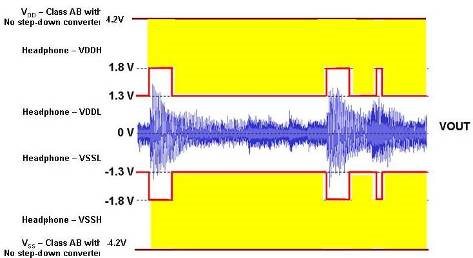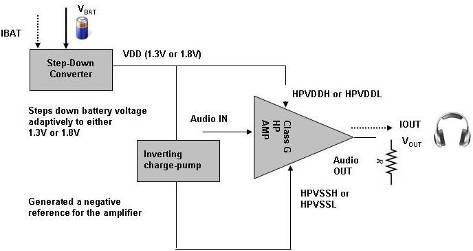Audio is an integral part of portable consumer electronic devices. An integrated headphone audio power amplifier helps amplify low-power baseband audio signals to drive crisp, clear audio frequencies when using the headphone. In addition, these amplifiers need to be extremely efficient in order to achieve longer battery life. To meet this challenge, most designers will use Class G audio amplifier topologies.
Typical linear audio amplifier topologies are Class A, Class B, Class C, and Class AB. Although these audio amplifiers are linear; But they are not very efficient.

A Class B (linear) amplifiers have a fixed power supply rail that consumes a fixed amount of power supply current to obtain an ideal output voltage. In the bridge load (BTL) state, the supply current is equal to the output current. The power supply current passing through the load causes a voltage drop on all output MOSFETs. These currents, which increase the MOSFET voltage drop, create a large power consumption in the amplifier, which is why the efficiency of Class AB amplifiers is only 50%.
What is Class G Topology?
At extremely high levels, the Class G topology is a variant of the Class AB topology with multiple power sources. The Class G topology takes advantage of the extremely high peak factor (10-20dB) of typical audio/music sources. This means that the peak audio signal is higher than the average audio signal (RMS). Most of the time, the audio signal is at a lower amplitude, and rarely shows a higher peak.
The new Class G topology uses an adaptive buck converter to generate a power supply voltage that moves with the audio signal. It generates a low supply voltage with ample margin for most average audio signals and switches to a high supply voltage to accommodate occasional peak voltages. Due to the adaptive nature of the power supply, the power consumption of typical music/audio sources with peak factor is greatly reduced. This results in lower battery current consumption, resulting in higher efficiency than Class AB architectures.
The power supply voltage is adaptive. It rises at high volume audio signals, thereby preventing large peak voltage distortion, while dropping at small audio peaks to reduce power consumption.
Class G topology works
Figure 2 depicts the operation of a Class G amplifier with a supply voltage of 1.3V at low audio voltage peaks and an adaptive rise to 1.8V at peak values. We use a buck DC/DC converter to generate these low power rails (see Figure 3).

Figure 2 Class G topology adaptive mobile amplifier power supply to achieve energy saving

The buck converter generates a high HPVDD voltage (HPVDDH) if the amplitude is increased due to high volume music or transient peak audio. The HPVDD rising rate is faster than the audio peak rising time. This prevents audio distortion or clipping. The audio quality and noise layer are not affected by HPVDD. This adaptive HPVDD minimizes power supply current while avoiding clipping and distortion. Since normal hearing levels are below 200mVRMS, HPVDD is most often at its lowest voltage, HPVDDL. Therefore, compared with traditional Class AB headphone amplifiers, Class G amplifiers have higher efficiency.
免责声明: 本文章转自其它平台,并不代表本站观点及立场。若有侵权或异议,请联系我们删除。谢谢! Disclaimer: This article is reproduced from other platforms and does not represent the views or positions of this website. If there is any infringement or objection, please contact us to delete it. thank you! |


